罗斯308商品代肉鸡营养标准
- 格式:pdf
- 大小:3.71 MB
- 文档页数:4

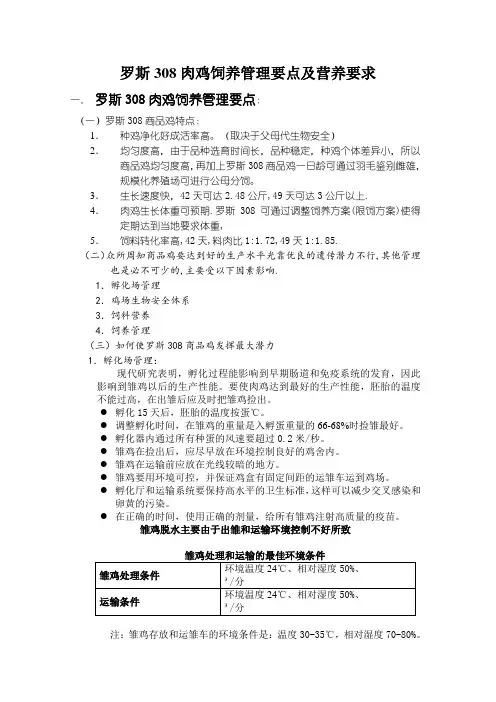
罗斯308肉鸡饲养管理要点及营养要求一.罗斯308肉鸡饲养管理要点:(一)罗斯308商品鸡特点:1.种鸡净化好成活率高。
(取决于父母代生物安全)2.均匀度高,由于品种选育时间长,品种稳定,种鸡个体差异小,所以商品鸡均匀度高,再加上罗斯308商品鸡一日龄可通过羽毛鉴别雌雄,规模化养殖场可进行公母分饲。
3.生长速度快,42天可达2.48公斤,49天可达3公斤以上.4.肉鸡生长体重可预期.罗斯308可通过调整饲养方案(限饲方案)使得定期达到当地要求体重,5.饲料转化率高,42天,料肉比1:1.72,49天1:1.85.(二)众所周知商品鸡要达到好的生产水平光靠优良的遗传潜力不行,其他管理也是必不可少的,主要受以下因素影响.1.孵化场管理2.鸡场生物安全体系3.饲料营养4.饲养管理(三)如何使罗斯308商品鸡发挥最大潜力1.孵化场管理:现代研究表明,孵化过程能影响到早期肠道和免疫系统的发育,因此影响到雏鸡以后的生产性能。
要使肉鸡达到最好的生产性能,胚胎的温度不能过高,在出雏后应及时把雏鸡捡出。
●孵化15天后,胚胎的温度按蛋℃。
●调整孵化时间,在雏鸡的重量是入孵蛋重量的66-68%时捡雏最好。
●孵化器内通过所有种蛋的风速要超过0.2米/秒。
●雏鸡在捡出后,应尽早放在环境控制良好的鸡舍内。
●雏鸡在运输前应放在光线较暗的地方。
●雏鸡要用环境可控,并保证鸡盒有固定间距的运雏车运到鸡场。
●孵化厅和运输系统要保持高水平的卫生标准,这样可以减少交叉感染和卵黄的污染。
●在正确的时间,使用正确的剂量,给所有雏鸡注射高质量的疫苗。
雏鸡脱水主要由于出雏和运输环境控制不好所致注:雏鸡存放和运雏车的环境条件是:温度30-35℃,相对湿度70-80%。
2.鸡场生物安全体系●最好实行全进全出制。
●尽可能避免来源于不同日龄且免疫状态不一致的种鸡群,最好来自同一种鸡群。
如果不能保证,应选择年龄相近的种鸡群。
●如果父母种鸡免疫效果较好,它可以为后代提供较高的母源抗体,并可以保护肉鸡免受疾病的侵害。
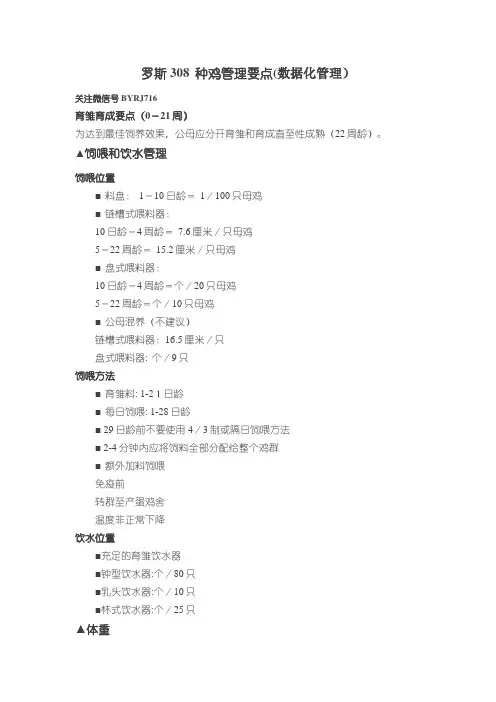
罗斯308 种鸡管理要点(数据化管理)关注微信号BYRJ716育雏育成要点(0-21周)为达到最佳饲养效果,公母应分开育雏和育成直至性成熟(22周龄)。
▲饲喂和饮水管理饲喂位置■ 料盘:1-10日龄=1/100只母鸡■ 链槽式喂料器:10日龄-4周龄=7.6厘米/只母鸡5-22周龄=15.2厘米/只母鸡■ 盘式喂料器:10日龄-4周龄=个/20只母鸡5-22周龄=个/10只母鸡■ 公母混养(不建议)链槽式喂料器:16.5厘米/只盘式喂料器: 个/9只饲喂方法■ 育雏料: 1-21日龄■ 每日饲喂: 1-28日龄■ 29日龄前不要使用4/3制或隔日饲喂方法■ 2-4分钟内应将饲料全部分配给整个鸡群■ 额外加料饲喂免疫前转群至产蛋鸡舍温度非正常下降饮水位置■充足的育雏饮水器■钟型饮水器:个/80只■乳头饮水器:个/10只■杯式饮水器:个/25只▲体重每周抽样称重并计算出平均体重和均匀度。
4周体重最重要,鸡群要健康,均匀度要良好■体重454克■确保鸡群15-22周时的体型要有适当的丰满度■避免忽高忽低不稳定的生长模式▲ 鸡舍环境光照■ 不要提前给光■ 3-22周期间每天8小时光照,0.5-1.0烛光(5.4-10.8勒克斯)■ 密切注意遮黑系统,不要有漏光现象温度和相对湿度■ 初始时育雏伞边缘的地面垫料温度为32.2℃(90℉)■ 每周降低2.7℃直至达到21.1℃■ 舍内最低保持相对湿度为50-60%通风■ 舍内的空气交换速率为每45-60秒钟换气一次■ 空气流速不应太快,以防鸡只受凉▲措施与免疫断喙■ 第5-7日龄断喙(操作不当会降低均匀度)球虫控制■ 抗球虫药物■ 球虫活苗(避免免疫反应强烈)■至关重要; 防止鸡群出现均匀度和继发性吸收不良等问题禽霍乱免疫程序■ 灭活苗■ 活苗(避免免疫反应强烈)■ 免疫程序必须根据当地该疾病的流行程度而定■ 免疫的实施技术和适宜的体重有助于降低潜在的负面影响罗斯-308 种母鸡的管理要点(22-65周)▲产蛋期的管理公母比例■ 22-26周龄期间每100只母鸡6-8.5只公鸡■ 27-65周龄期间每100只母鸡8.5只公鸡■ 整个生产周期随时淘汰不合格的母鸡▲饲喂和饮水管理采食位置■ 链槽式饲喂器:15.2厘米/只母鸡■ 盘式饲喂器:个/10只母鸡提高均匀度和产蛋率的饲喂技巧■产蛋率达到5%之前采用隔日饲喂或5/2制饲喂■从5%产蛋率开始至鸡群淘汰采用每日饲喂方法■高峰料(基于2,865大卡能量/公斤)(2800kcal/kg)料量:156-163克442-468大卡/只/日(158—167g)给高峰料的时间:40-60%产蛋率时耗料时间:3-4小时通过高峰后较大幅度(?)地减料来控制鸡只体重饮水位置■ 钟型饮水器:个/80只母鸡■ 乳头式饮水器:个/10只母鸡■杯式饮水器:个/25只母鸡▲鸡舍环境如需将育成鸡群转群至产蛋鸡舍,转群工作应在六小时之内完成,转群后要密切观察鸡只,确保所有鸡只能够采食和饮水。
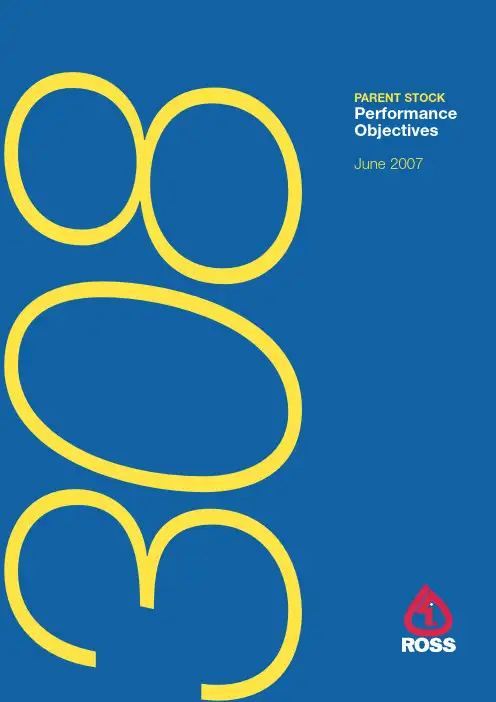
8PARENT STOCK Performance Objectives June 2007 0IntroductionThis booklet contains the performance objectives for Ross 308Parent Stock and is to be used with the Ross 308Parent Stock Management Manual.PerformancePerformance can be influenced by many factors including flock management, health status and climatic conditions. These objectives indicate the performance which can be achieved under good management and environmental conditions and when feeding recommended nutrient levels.Poultry production is a global activity but across the world there are differing management strategies adapted to local economic conditions. The objectives are therefore presented in two sections, recognising two distinct strategies for breeder management which can be summarised as:To have 5% production at 25 weeks of age, with firstlight stimulation after 21 weeks (147 days +)ORTo have 5% production at 23 weeks of age, with firstlight stimulation before 21 weeks (up to 146 days of age)The former is the most common strategy worldwide as it gives distinct advantages in early egg size, chick number and broiler chick quality. The performance objectives for this strategy are included in of this booklet.describes the strategy to achieve 5% production at 23 weeks of age.Within the two major strategies variations may occur for a variety of other reasons. For example, feed consumption can be affected significantly by form of feed, energy level and house temperature. Information in this booklet should not, therefore, be regarded as a specification but as a ‘Performance Objective’.Performance levels given assume flocks are managed with separate sex feeding. We recommend that you use the objectives which best relate to your production strategy.All weight measurements are shown in both and to reflect the global nature of this publication.In the tables values are rounded, this may result in small inaccuracies when using the objectives to calculate other performance statistics.For further information on the management of Ross stock, please contact your local Technical Service Manager or the Technical Services Department.1Section 1Section 2Section 2Section imperial (lb/oz)metric (kg/g)Contents05Performance Summary 06Male Bodyweight and Feeding Programme 07Female Bodyweight and Feeding Programme 08Female Out of Season Bodyweight and Feeding Programme 09Weekly Egg Production 10Weekly Egg Weight and Egg Mass 11Weekly Hatchability and Chick Production 13Performance Summary 14Male Bodyweight and Feeding Programme 15Female Bodyweight and Feeding Programme 16Weekly Egg Production 17Weekly Egg Weight and Egg Mass 18Weekly Hatchability and Chick Production 2Section 2Section 2Section 2Section 2Section 2Section 1Section 1Section 1Section 1Section 1Section 1Section 1SectionTo have 5% production at 25 weeks of age, with firstlight stimulation after 21 weeks (147 days +) 05Performance Summary 06Male Bodyweight and Feeding Programme 07Female Bodyweight and Feeding Programme 08Female Out of Season Bodyweight and Feeding Programme 09Weekly Egg Production 10Weekly Egg Weight and Egg Mass 11Weekly Hatchability and Chick Production 1Section 1Section 1Section 1Section 1Section 1Section 1Section 1SectionPerformance SummaryGlobal Ross 308 breeder performance objectives for birds light stimulated after 21 weeks of age (147 days +)Summary of 40 weeks of productionNOTE * Feed amounts expressed in the table do not include male feed allocations.KEY (kg/g)– metric measurement (lb/oz)– imperial measurementNOTES Weekly bodyweight gain beyond 30weeks (210 days) should average approximately 30 grammes (0.06–0.07lb).This profile allows the male to reach sexual maturity by first eggs. Field performance has shown that this practice ensures that the body condition of the males is not compromised so they will maintain the best possible fertility levels.These quantities are a guide only; actual feed levels will depend on the energy value of individual rations. The feed allowance should increase throughout the lay period and never decrease.In the table values are rounded, this may result in small inaccuracies when using the objectives to calculate other performance statistics.1 Based on 2800 kcal ME/kg (1270 kcal KEY (kg/g)– metric measurement (lb/oz)– imperial measurementNOTES Feed quantities are given as a guide.Birds should be fed the amount of feed they need to achieve the bodyweight target curve.Weekly bodyweight gain beyond 33 weeks (231 days) should average approximately 15–20 grammes (0.03–0.04lb).In the table values are rounded, this may result in small inaccuracies when using the objectives to calculate other performance statistics.1 Based on 2800 kcal ME/kg (1270 kcal KEY (kg/g)– metric measurement (lb/oz)– imperial measurementNOTES Feed quantities are given as a guide.Birds should be fed the amount of feed they need to achieve the bodyweight target curve.Weekly bodyweight gain beyond 33 weeks (231 days) should average approximately 15–20 grammes (0.03–0.04lb).In the table values are rounded, this may result in small inaccuracies when using the objectives to calculate other performance statistics.1 Based on 2800 kcal ME/kg (1270 kcal Female Out of Season Bodyweight and Feeding ProgrammeKEY (kg/g)– metric measurement (lb/oz)– imperial measurementROSS 308PARENT STOCK: Performance Objectives 1Weekly Egg Production5% production at25 weeks of ageROSS 308PARENT STOCK: Performance Objectives 1Weekly Egg Weight and Egg MassNOTE * Egg mass = (Hen-week (%) x Egg weight (g)) / 100KEY (kg/g)– metric measurement (lb/oz)– imperial measurement 5% production at 25 weeks of ageROSS 308PARENT STOCK: Performance Objectives 1Weekly Hatchability and Chick Production5% production at25 weeks of ageTo have 5% production at 23 weeks of age, with firstlight stimulation before 21 weeks (up to 146 days of age)13Performance Summary 14Male Bodyweight and Feeding Programme 15Female Bodyweight and Feeding Programme 16Weekly Egg Production 17Weekly Egg Weight and Egg Mass 18Weekly Hatchability and Chick Production 2Section 2Section 2Section 2Section 2Section 2Section 2SectionNOTE * Feed amounts expressed in the table do not include male feed allocations.KEY (kg/g)– metric measurement (lb/oz)– imperial measurement Performance SummaryGlobal Ross 308 breeder performance objectives for birds light stimulated before 21 weeks of age (up to 146 days of age)Summary of 40 weeks of productionNOTES Weekly bodyweight gain beyond 30 weeks (210 days) should average approximately 30 grammes (0.06–0.07lb).This profile allows the male to reach sexual maturity by first eggs. Field performance has shown that this practice ensures that the body condition of the males is not compromised so they will maintain the best possible fertility levels.These quantities are a guide only; actual feed levels will depend on the energy value of individual rations. The feed allowance should increase throughout the lay period and never decrease. In the table values are rounded, this may result in small inaccuracies when using the objectives to calculate other performance statistics.1 Based on 2800 kcal ME/kg (1270 kcal ME/lb) and 2600 kcal ME/kg (1179 kcal ME/lb) between 42 and 104 days of age.Adjustments must be made to reflect feeding differing energy levels. KEY (kg/g)– metric measurement (lb/oz)– imperial measurementNOTES Feed quantities are given as a guide.Birds should be fed the amount of feed they need to achieve the bodyweight target curve.Weekly bodyweight gain beyond 33 weeks (231 days) should average approximately 15–20 grammes (0.03–0.04lb).In the table values are rounded, this may result in small inaccuracies when using the objectives to calculate other performance statistics.1 Based on 2800 kcal ME/kg (1270 kcal ME/lb) and 2600 kcal ME/kg (1179 kcal ME/lb) between 42 and 104 days of age.Adjustments must be made to reflect feeding differing energy levels.KEY (kg/g)– metric measurement (lb/oz)– imperial measurementWeekly Egg ProductionWeekly Egg Weight and Egg MassKEY(kg/g)– metric measurement (lb/oz)– imperial measurementWeekly Hatchability and Chick ProductionROSS 308PARENT STOCK: Performance Objectives NotesNewbridge, MidlothianEH28 8SZ, Scotland, UKt. +44 (0) 131 333 1056f. +44 (0) 131 333 3296infoworldwide@ June 2007Cummings Research Park, 5015 Bradford Drive Huntsville, Alabama 35805, USA t. +1 256 890 3800f. +1 256 890 3919info@Every attempt has been made to ensure the accuracy and relevance of the information presented. However, Aviagen accepts no liability for the consequences of using the information for the management of chickens.For further information on the management of Ross stock, please contact your local Technical Service Manager or the Technical Services Department.。
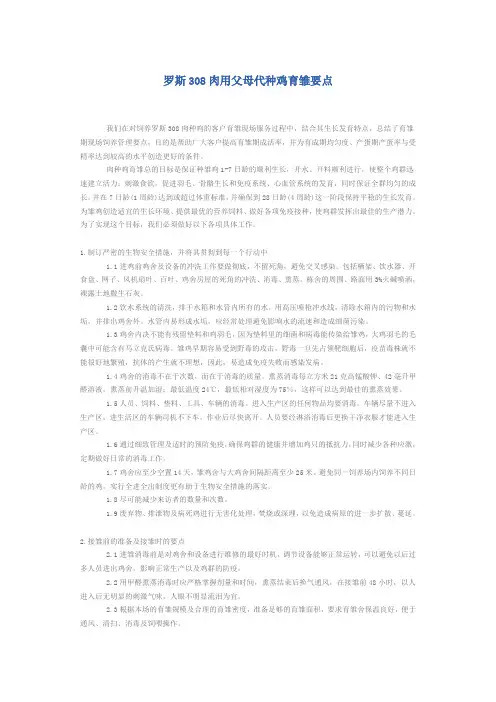
罗斯308肉用父母代种鸡育雏要点我们在对饲养罗斯308肉种鸡的客户育雏现场服务过程中,结合其生长发育特点,总结了育雏期现场饲养管理要点,目的是帮助广大客户提高育雏期成活率,并为育成期均匀度、产蛋期产蛋率与受精率达到较高的水平创造更好的条件。
肉种鸡育雏总的目标是保证种雏鸡1-7日龄的顺利生长,开水、开料顺利进行,使整个鸡群迅速建立活力;刺激食欲,促进羽毛、骨骼生长和免疫系统、心血管系统的发育,同时保证全群均匀的成长。
并在7日龄(1周龄)达到或超过体重标准,并确保到28日龄(4周龄)这一阶段保持平稳的生长发育。
为雏鸡创造适宜的生长环境、提供最优的营养饲料、做好各项免疫接种,使鸡群发挥出最佳的生产潜力。
为了实现这个目标,我们必须做好以下各项具体工作。
1.制订严密的生物安全措施,并将其贯彻到每一个行动中1.1进鸡前鸡舍及设备的冲洗工作要做彻底,不留死角,避免交叉感染。
包括栖架、饮水器、开食盘、网子、风机扇叶、百叶、鸡舍房屋的死角的冲洗、消毒、熏蒸。
栋舍的周围、路面用3%火碱喷洒,裸露土地撒生石灰。
1.2饮水系统的清洗,排干水箱和水管内所有的水,用高压喷枪冲水线,清除水箱内的污物和水垢,并排出鸡舍外。
水管内易形成水垢,应经常处理避免影响水的流速和造成细菌污染。
1.3鸡舍内决不能有残留垫料和鸡羽毛,因为垫料里的细菌和病毒能传染给雏鸡,大鸡羽毛的毛囊中可能含有马立克氏病毒。
雏鸡早期容易受到野毒的攻击,野毒一旦先占领靶细胞后,疫苗毒株就不能很好地繁殖,抗体的产生就不理想,因此,易造成免疫失败而感染发病。
1.4鸡舍的消毒不在于次数,而在于消毒的质量。
熏蒸消毒每立方米21克高锰酸钾、42毫升甲醛溶液。
熏蒸前升温加湿:最低温度24℃,最低相对湿度为75%,这样可以达到最佳的熏蒸效果。
1.5人员、饲料、垫料、工具、车辆的消毒。
进入生产区的任何物品均要消毒。
车辆尽量不进入生产区,进生活区的车辆司机不下车,作业后尽快离开。
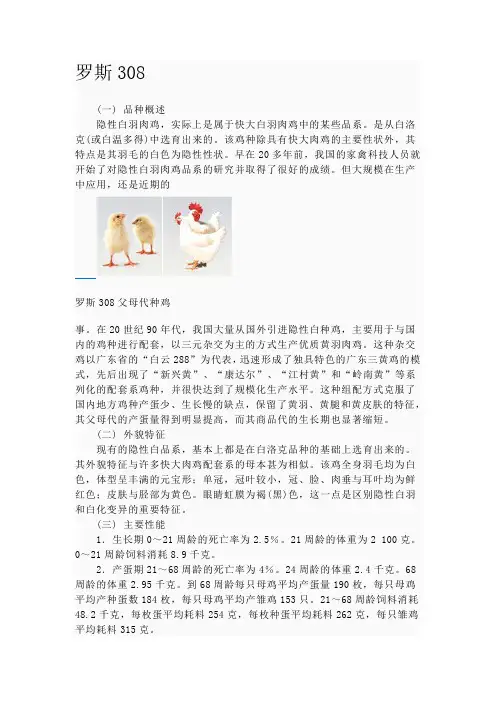
罗斯308(一) 品种概述隐性白羽肉鸡,实际上是属于快大白羽肉鸡中的某些品系。
是从白洛克(或白温多得)中选育出来的。
该鸡种除具有快大肉鸡的主要性状外,其特点是其羽毛的白色为隐性性状。
早在20多年前,我国的家禽科技人员就开始了对隐性白羽肉鸡品系的研究并取得了很好的成绩。
但大规模在生产中应用,还是近期的罗斯308父母代种鸡事。
在20世纪90年代,我国大量从国外引进隐性白种鸡,主要用于与国内的鸡种进行配套,以三元杂交为主的方式生产优质黄羽肉鸡。
这种杂交鸡以广东省的“白云288”为代表,迅速形成了独具特色的广东三黄鸡的模式,先后出现了“新兴黄”、“康达尔”、“江村黄”和“岭南黄”等系列化的配套系鸡种,并很快达到了规模化生产水平。
这种组配方式克服了国内地方鸡种产蛋少、生长慢的缺点,保留了黄羽、黄腿和黄皮肤的特征,其父母代的产蛋量得到明显提高,而其商品代的生长期也显著缩短。
(二) 外貌特征现有的隐性白品系,基本上都是在白洛克品种的基础上选育出来的。
其外貌特征与许多快大肉鸡配套系的母本甚为相似。
该鸡全身羽毛均为白色,体型呈丰满的元宝形;单冠,冠叶较小,冠、脸、肉垂与耳叶均为鲜红色;皮肤与胫部为黄色。
眼睛虹膜为褐(黑)色,这一点是区别隐性白羽和白化变异的重要特征。
(三) 主要性能1.生长期0~21周龄的死亡率为2.5%。
21周龄的体重为2 100克。
0~21周龄饲料消耗8.9千克。
2.产蛋期21~68周龄的死亡率为4%。
24周龄的体重2.4千克。
68周龄的体重2.95千克。
到68周龄每只母鸡平均产蛋量190枚,每只母鸡平均产种蛋数184枚,每只母鸡平均产雏鸡153只。
21~68周龄饲料消耗48.2千克,每枚蛋平均耗料254克,每枚种蛋平均耗料262克,每只雏鸡平均耗料315克。
(四) 饲养管理要点根据在海南省的饲养观察,德国的隐性白比标准肉用种母系的成熟期要早。
其24周龄时,产蛋率达到5%,体重的相对增重也达到最大值,表现出体成熟与性成熟的基本同步。
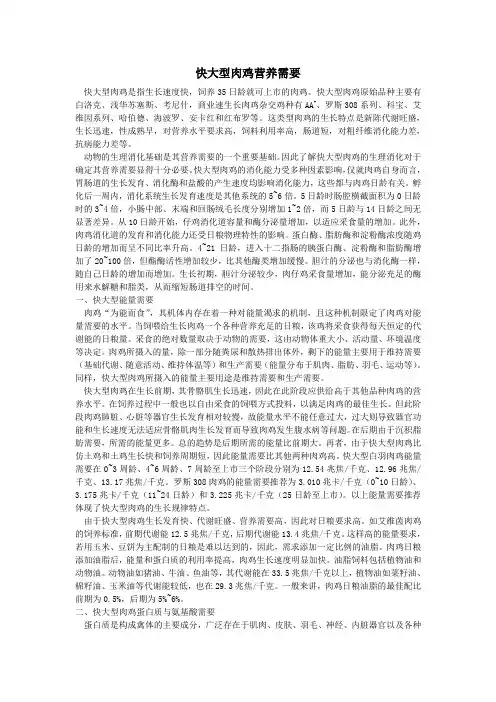
快大型肉鸡营养需要快大型肉鸡是指生长速度快,饲养35日龄就可上市的肉鸡。
快大型肉鸡原始品种主要有白洛克、浅华苏塞斯、考尼什,商业速生长肉鸡杂交鸡种有AA+、罗斯308系列、科宝、艾维因系列、哈伯德、海波罗、安卡红和红布罗等。
这类型肉鸡的生长特点是新陈代谢旺盛,生长迅速,性成熟早,对营养水平要求高,饲料利用率高,肠道短,对粗纤维消化能力差,抗病能力差等。
动物的生理消化基础是其营养需要的一个重要基础。
因此了解快大型肉鸡的生理消化对于确定其营养需要显得十分必要。
快大型肉鸡的消化能力受多种因素影响,仅就肉鸡自身而言,胃肠道的生长发育、消化酶和盐酸的产生速度均影响消化能力,这些都与肉鸡日龄有关。
孵化后一周内,消化系统生长发育速度是其他系统的5~6倍。
5日龄时肠腔横截面积为0日龄时的3~4倍,小肠中部、末端和回肠绒毛长度分别增加1~2倍,而5日龄与14日龄之间无显著差异。
从10日龄开始,仔鸡消化道容量和酶分泌量增加,以适应采食量的增加。
此外,肉鸡消化道的发育和消化能力还受日粮物理特性的影响。
蛋白酶、脂肪酶和淀粉酶浓度随鸡日龄的增加而呈不同比率升高。
4~21日龄,进入十二指肠的胰蛋白酶、淀粉酶和脂肪酶增加了20~100倍,但酯酶活性增加较少,比其他酶类增加缓慢。
胆汁的分泌也与消化酶一样,随自己日龄的增加而增加。
生长初期,胆汁分泌较少,肉仔鸡采食量增加,能分泌充足的酶用来水解糖和脂类,从而缩短肠道排空的时间。
一、快大型能量需要肉鸡“为能而食”,其机体内存在着一种对能量渴求的机制,且这种机制限定了肉鸡对能量需要的水平。
当饲喂给生长肉鸡一个各种营养充足的日粮,该鸡将采食获得每天恒定的代谢能的日粮量。
采食的绝对数量取决于动物的需要,这由动物体重大小、活动量、环境温度等决定。
肉鸡所摄入的量,除一部分随粪尿和散热排出体外,剩下的能量主要用于维持需要(基础代谢、随意活动、维持体温等)和生产需要(能量分布于肌肉、脂肪、羽毛、运动等)。
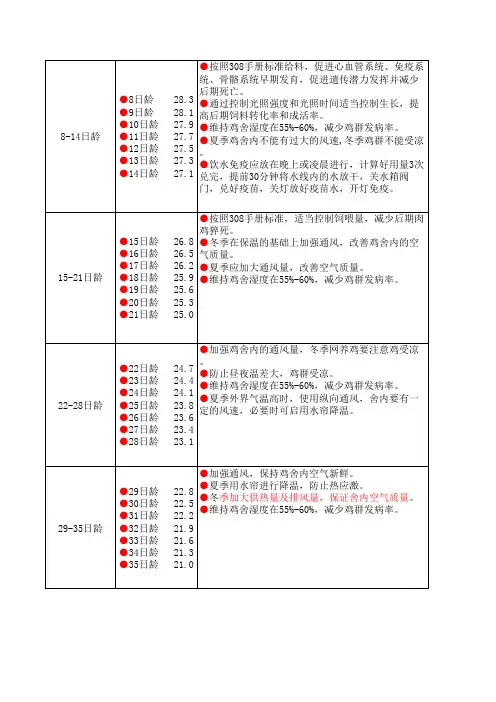
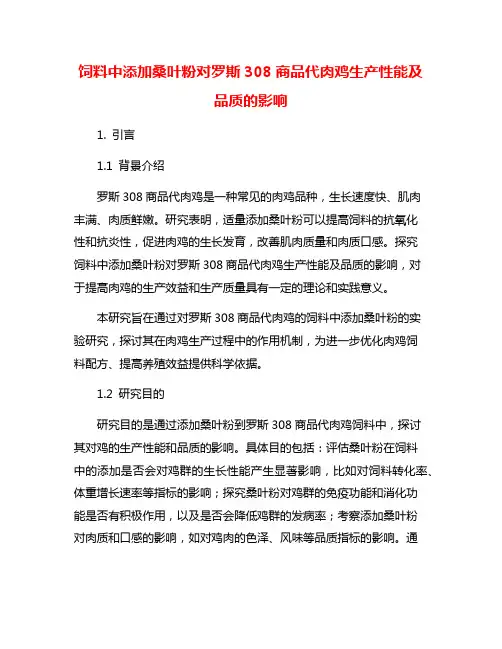
饲料中添加桑叶粉对罗斯308商品代肉鸡生产性能及品质的影响1. 引言1.1 背景介绍罗斯308商品代肉鸡是一种常见的肉鸡品种,生长速度快、肌肉丰满、肉质鲜嫩。
研究表明,适量添加桑叶粉可以提高饲料的抗氧化性和抗炎性,促进肉鸡的生长发育,改善肌肉质量和肉质口感。
探究饲料中添加桑叶粉对罗斯308商品代肉鸡生产性能及品质的影响,对于提高肉鸡的生产效益和生产质量具有一定的理论和实践意义。
本研究旨在通过对罗斯308商品代肉鸡的饲料中添加桑叶粉的实验研究,探讨其在肉鸡生产过程中的作用机制,为进一步优化肉鸡饲料配方、提高养殖效益提供科学依据。
1.2 研究目的研究目的是通过添加桑叶粉到罗斯308商品代肉鸡饲料中,探讨其对鸡的生产性能和品质的影响。
具体目的包括:评估桑叶粉在饲料中的添加是否会对鸡群的生长性能产生显著影响,比如对饲料转化率、体重增长速率等指标的影响;探究桑叶粉对鸡群的免疫功能和消化功能是否有积极作用,以及是否会降低鸡群的发病率;考察添加桑叶粉对肉质和口感的影响,如对鸡肉的色泽、风味等品质指标的影响。
通过研究,旨在为养殖行业提供更有效的饲料配方,提高肉鸡的生产性能和品质,促进行业的发展和生态环境的改善。
1.3 研究意义是指研究的意义和价值,对行业和学术界有何贡献和影响。
本研究的研究意义主要体现在以下几个方面:通过对饲料中添加桑叶粉对罗斯308商品代肉鸡生产性能及品质的影响进行研究,可以为饲料添加剂的开发和应用提供新的理论和实践依据。
随着畜禽养殖业的发展,人们对提高肉鸡生产性能和产品品质的需求也越来越高,而饲料作为肉鸡生产的重要组成部分,饲料添加剂的选择和使用对整个生产过程至关重要。
本研究的结果将为合理选择和使用饲料添加剂提供参考,有助于提高养殖效益和产品质量。
本研究可以为推动畜禽养殖业的可持续发展提供参考和支撑。
随着人口的增加和肉类消费需求的增加,畜禽养殖业的发展面临着新的挑战和机遇。
通过探究饲料中添加桑叶粉对肉鸡生产的影响,可以为发展绿色、环保的畜禽养殖技术提供借鉴和启示,有助于实现畜禽养殖业的可持续发展。

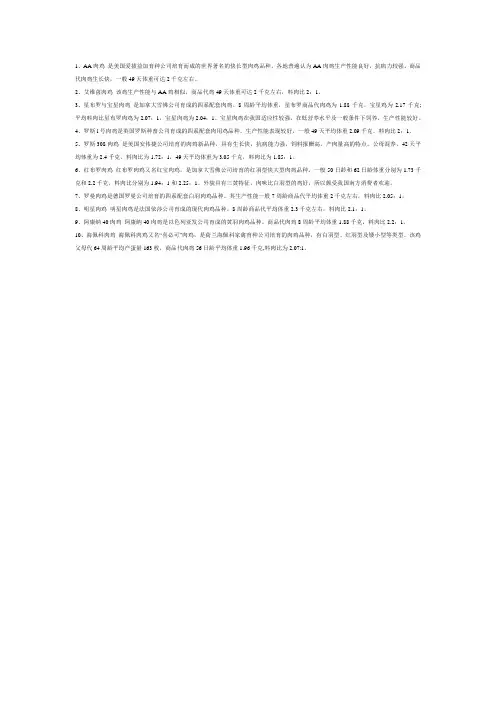
1、AA肉鸡是美国爱拔益加育种公司培育而成的世界著名的快长型肉鸡品种。
各地普遍认为AA肉鸡生产性能良好,抗病力较强。
商品代肉鸡生长快,一般49天体重可达2千克左右。
2、艾维茵肉鸡该鸡生产性能与AA鸡相似,商品代鸡49天体重可达2千克左右,料肉比2:1。
3、星布罗与宝星肉鸡是加拿大雪佛公司育成的四系配套肉鸡。
8周龄平均体重,星布罗商品代肉鸡为1.88千克,宝星鸡为2.17千克;平均料肉比星布罗肉鸡为2.07:1,宝星肉鸡为2.04:1。
宝星肉鸡在我国适应性较强,在低营养水平及一般条件下饲养,生产性能较好。
4、罗斯l号肉鸡是英国罗斯种畜公司育成的四系配套肉用鸡品种。
生产性能表现较好,一般49天平均体重2.09千克,料肉比2:1。
5、罗斯308肉鸡是美国安伟捷公司培育的肉鸡新品种,具有生长快,抗病能力强,饲料报酬高,产肉量高的特点。
公母混养,42天平均体重为2.4千克,料肉比为1.72:1,49天平均体重为3.05千克,料肉比为1.85:1。
6、红布罗肉鸡红布罗肉鸡又名红宝肉鸡,是加拿大雪佛公司培育的红羽型快大型肉鸡品种。
一般50日龄和62日龄体重分别为1.73千克和2.2千克,料肉比分别为1.94:1和2.25:1。
外貌具有三黄特征,肉味比白羽型的鸡好,所以颇受我国南方消费者欢迎。
7、罗曼肉鸡是德国罗曼公司培育的四系配套白羽肉鸡品种。
其生产性能一般7周龄商品代平均体重2千克左右,料肉比2.05:1。
8、明星肉鸡明星肉鸡是法国依莎公司育成的现代肉鸡品种。
8周龄商品代平均体重2.3千克左右,料肉比2.1:1。
9、阿康纳40肉鸡阿康纳40肉鸡是以色列亚发公司育成的黄羽肉鸡品种。
商品代肉鸡8周龄平均体重1.88千克,料肉比2.2:1。
10、海佩科肉鸡海佩科肉鸡又名“喜必可”肉鸡,是荷兰海佩科家禽育种公司培育的肉鸡品种,有白羽型、红羽型及矮小型等类型。
该鸡父母代64周龄平均产蛋量163枚,商品代肉鸡56日龄平均体重1.96千克,料肉比为2.07:1。
饲料中添加桑叶粉对罗斯308商品代肉鸡生产性能及品质的影响作者:李化秀周象海赵东晓聂玉霞梁明芝于海静施新琴郭光来源:《山东农业科学》2019年第05期摘要:通过在罗斯308商品代肉鸡饲料中添加不同剂量的桑叶粉,统计商品代肉鸡在日粮、体重、饲料转化率及肉品质等方面的不同,研究不同配方桑叶饲料对肉鸡生产性能及品质的影响。
结果表明,饲料中添加桑叶粉对肉鸡的生长指标影响不大,但是可以有效提高肉鸡的屠体重比率、胸肌比率,普遍提高鸡肉中蛋白质及蛋氨酸等氨基酸的含量,从而提高鸡肉品质。
综合各指标,桑叶添加量以3%为佳。
关键词:桑叶粉;肉鸡;生产性能;肉品质中图分类号:S831.5文献标识号:A文章编号:1001-4942(2019)05-0135-04桑叶中富含粗蛋白、粗脂肪、粗纤维、维生素、氨基酸和矿物元素等,以及植物甾醇、黄酮类、生物碱和多糖等多种可调节机体免疫力的生物活性物质。
桑叶除了是家蚕的天然食物外,还具有散风热、泄肺热的作用[1-3]。
研究表明,桑叶中营养成分如氨基酸、矿物质和维生素等均高于“牧草之王”苜蓿[2-4],氨基酸含量丰富且比例适宜,其中谷氨酸含量最高,在糖代谢及蛋白质代谢过程中有着重要的作用,此外,赖氨酸和苏氨酸的含量也较高。
在畜禽饲料中加入桑叶有利于调节饲料氨基酸平衡,而且对所有家畜都具有很好的适口性[5],有望在满足家畜营养的同时,作为新型添加剂解决现代畜牧生产中抗生素残留问题[6]。
因此将桑叶粉添加到牛、羊、猪、兔等畜饲料中以及鸡、鸭家禽饲料中的报道层出不穷,但效果不尽相同[7]。
本研究将桑叶粉按照不同比例添加到罗斯308商品代肉鸡饲料中,研究桑叶饲料对商品代肉鸡生产性能及品质的影响,探讨其作为肉鸡饲料的最佳添加量,为后期桑叶利用及开发桑叶饲料提供参考。
1材料与方法1.1试验场地山东省蚕业研究所南院试验场。
1.2试验动物与分组选用商品代肉鸡品种罗斯308共600只公鸡,共同育雏21d后,从中选取体重适中的432只,分为对照(CK)、1%、3%、5%、7%和9%共6个处理,每个处理72只鸡。
罗斯ROSS308父母代肉用种鸡饲养管理手册关键年龄段的标准为了生产出最大数量的商品代雏鸡, 我们必须了解父母代种鸡在不同年龄段的特殊要求, 父母代种鸡关键年龄段的标准总结如下:日龄主要目的1-3日龄刺激食欲3-28日龄达到7日龄、14日龄、21日龄、28日龄体重标准28日龄分栏,28日龄可以采用两种方式进行分栏,使变异系数小于12% 28-56日龄控制分栏后周增重56-70日龄保持鸡群理想的周增重70日龄重新制定体重标准(如需要)70-105日龄保持鸡群理想的周增重105日龄增加饲料,刺激生长,重新制定体重标准(如需要)105-140日龄保持鸡群理想的周增重140-154日龄开始增加光照时间140-161日龄保持鸡群理想的周增重,重点是获得理想的性成熟均匀度161-210日龄为产蛋期体重增长和理想的蛋重增加喂料量210日龄-淘汰通过减料控制体重增长和蛋重,通过观察鸡群来加强公鸡的管理,淘汰鸡舍内不交配的公鸡,以获得良好的受精率.第一篇育雏育成期的管理0-105日龄(0-15周龄)页数内容公鸡和母鸡的特定管理要求育雏期的管理体重控制和饲喂程序体重和均匀度的监测通过控制喂料量以达到体重标准通过分栏控制均匀度公鸡和母鸡的特定管理要求目的满足父母代公鸡和母鸡在育雏育成期的各项需求,使之为性成熟做好准备。
原理罗斯父母代种鸡具有罗斯商品代肉鸡生长速度快、饲料转化率高的特性,因此,父母代种鸡在育雏育成期应按照体重标准进行饲养,使种公鸡和种母鸡在整个生产期获得最佳的生产性能。
要达到育雏育成期的管理目的,必须使种鸡达到饲养日体重标准,保持准确的称重及控制喂料量。
可以通过对种鸡按体重分栏饲养而获得良好的均匀度。
图1显示育成期种鸡的各组织和器官在不同年龄段的生长发育状况。
图2(页)表明根据图1显示的种鸡在不同年龄段组织和器官的生长发育状况所制定的种鸡饲养管理要点。
尽管公母鸡的体重标准不同,但育成期的管理原则基本相同。